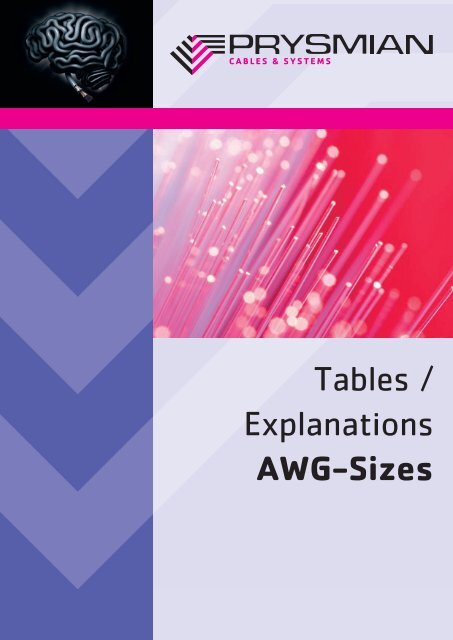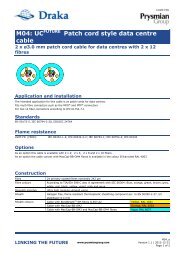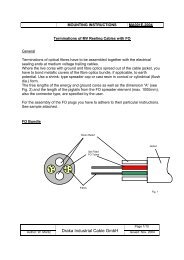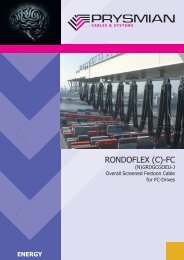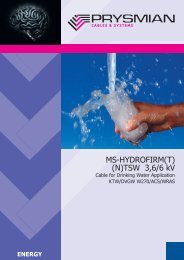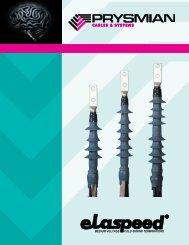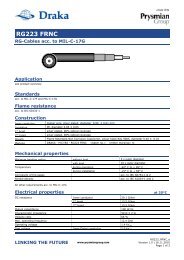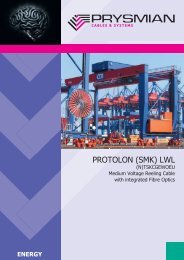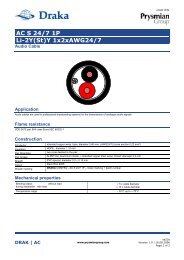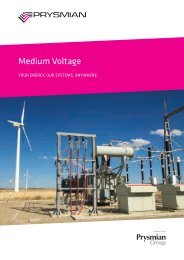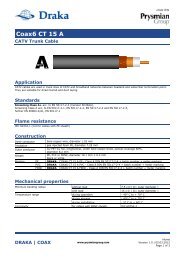Tables / Explanations AWG-Sizes - Prysmian Group
Tables / Explanations AWG-Sizes - Prysmian Group
Tables / Explanations AWG-Sizes - Prysmian Group
Create successful ePaper yourself
Turn your PDF publications into a flip-book with our unique Google optimized e-Paper software.
<strong>Tables</strong> /<strong>Explanations</strong><strong>AWG</strong>-<strong>Sizes</strong>
Type / type designationThe type designates a group of flexible electriccables which have the same design features andwhich are intended for a specific range of technicalapplications.The type designation is a letter combination accordingto DIN VDE, which describes the type in codedform 1) .LYSLTK Lightweight lift control cable, up to30 m suspension lenghtNGFLGÖU Flat rubber-sheathed flexible festooncable PLANOFLEXNGRDGÖU Round rubber-sheathed flexible festooncable also suitable for simple reelingRONDOFLEX(N)SHTÖU Tough rubber-sheathed flexible reel ingcable CORDAFLEXNGRDGOU Round rubber-sheathed flexible festooncable also suitable for simple reelingRONDOFLEX(N)SHTOU Tough rubber-sheathed flexible reelingcable CORDAFLEX(N)TSCGEWOUH.V. reeling cables PROTOLON, 3 to 30kVYSLTK Lift control cable, up to 50 m suspensionlengthYSLTO Special cable for gravity-fed collectorbasket operation SPREADERFLEXYSLYCYK Lift control cable, up to 150 m suspensionlengthThe type designation can be deciphered as follows:..C.. Conducting metal casing over thestranded cores or between the inner andouter sheath (shield)(C) Additional information about the shieldfor the conductor crosssections, e.g.12x1 (C) which means 1 mm 2 individuallyshielded or 6x(2x1) C which means 2x1mm 2 twisted and shielded pairs..CE.. Conducting metal casing over the insulationof the outer conductors..CG.. Conducting non-metal casing over thestranded cores or between the inner andouter sheath (shield)..CGE.. Conducting non-metal casing over theinsulation of the outer conductorsFL Flat cableFM Telecommunication lines within the cableFO Fibre-optic (German LWL)GRubber compoundHS High-voltage (H.V.)-J Additional information about the type:with green/yellow marked coreKRubber cross in the centre of the cableor low-temperature resistant in the caseof lift control cablesand (K) as a supplement to the trademark,e.g. CORDAFLEX(K)KON Concentric protective conductor betweenthe inner and outer sheath or concentriccontrol/monitoring conductorL... Lightweight cable designLWL Fibre-optic (FO)(M) Suffix to the trademark, e.g. OPTOFLEX(M) for MiningMS Medium-voltage (M.V.)NDesign according to the correspondingstandard(N) Based on a standard-O Additional information about the type:without green/yellow marked coreÖ 1 ) Oil-resistant outer sheath (according toDIN VDE 0473, Part 2-1, Para. 10) (OE)RD Round cable..SHT... 1 kV reeling cable..SL.. Control cable(SM) Flexible cables for extremely highmechanical stress, previously used assupplement to the trademarksCORDAFLEX(SM) and PROTOLON(SM)(previously derived from Siemensmachine cable)(SMK) New cable generation combining the highrequirement profiles of (SM) and (K)(SM-R) R for reduced, i.e same diameter asPROTOLON standard cable, otherwiseadvanced PROTOLON(SM) designST Control cores within the cable..T.. Support element..TS.. Reeling cableUFlame-retardant outer sheath (accordingto DIN VDE 0472, Part 804)„non-inflammable“ÜL 1 Monitoring conductor within the cable(UEL)..W.. Weather resistantYPVC compoundZPrinted numbers/3 Protective-earth conductor uniformlydistributed in the three interstices/3E Protective-earth conductor uniformlydistributed over the insulation of theouter conductor1) The German characters „Ö“ and „Ü“ are transformedinto the international „OE“ and „UE“, respectively.
TABLES / EXPLANATIONS <strong>AWG</strong>-SIZESApprovals/standardsFlexible electric cables for cranes and materialhandling equipment have to be able to cope withthe expected operation and installation conditions.Details are given in the application and installationguidelines. In addition, flexible electric cablesfor cranes and material handling equipment aredescribed with regard to design and tests as laiddown in national and international standards (designregulations).Application and installation guidelinesDIN VDE 0298, Part 3Application of cables and flexible cords in powerinstallations> General information on cablesDIN VDE 0298, Part 4Application of cables and flexible cords in powerinstallations> Recommended values for current-carryingcapacity of cablesDIN VDE 0100, Part 726Erection of power installations with rated voltagesup to 1000 V> CranesDIN VDE 0101Erection of power installations with rated voltagesabove 1 kVDIN VDE 0118Specification for the erection of electrical installationsin underground minesDIN VDE 0168Specification for the erection of electrical installationsin open-cast mines, quarries and similar worksEN 81 Part 1Safety regulations for the construction and installationof passenger lifts, goods lifts and service liftsNational standardDIN VDE (DIN = German Standards Institute; VDE =Association of German Electrical Engineers)Germany is the only country which has issued specialdesign regulations for flexible electric cables forcranes and material handling equipment. The toughrubbersheathed flexible reeling cables CORDAFLEXNSHTOEU, the H.V. reeling cables PROTOLONNTS..WOEU and the flat rubber-sheathed flexiblecables PLANOFLEX NGFLGOEU are described andstandardized in DIN VDE 0250. This set of standardshas found recognition in Europe and in manycountries outside Europe and is accepted as orspecified as state of the art.The new generation of reeling cables (described inthis catalog) generally conforms to these standards,however, they deviate in a number of points, where itis necessary to achieve an enhanced feature profile.Efforts are being made to have these modificationsincorporated in the relevant standards.No such design regulations exist for RONDOFLEX,SPREADERFLEX, OPTOFLEX and lift control cables.These are <strong>Prysmian</strong> special cables, the design ofwhich is based on existing design regulations orgeneral regulations of DIN VDE.International standardInternational standards have been taken into accountfor all our cables where this was possible. For useat an international level, some design featuresof flexible electric cables for cranes and materialhandling equipment covered by DIN VDE are alsolisted or certified in line with UL or MSHA.U L = Underwriters Laboratories Inc. UL is an approvaland standardization institute in the USA. The ULstandard is requested in North America and also tosome extent in the Far East.MSHA = Mine Safety and Health AdministrationThe MSHA listing was specially issued for thecorresponding electric cables by the Deep MineSafety office at Harrisburg, USA. The flame-retardantbehaviour of the cables was tested.Design regulationsThe summary in table 4/1 (page 4/5) shows all thedesign regulations/standards, according to whichthe flexible electric cables for cranes and materialhandling equipment are designed and manufactured.The following distinctions are made between nationaland international regulations:
Approval/standardsFlexible cables Type German standard DIN VDE international standardsCORDAFLEX(SM) /-RS NSHTOEU DIN VDE 0250, Part 814 UL File E 113313MSHA P-189-1PLANOFLEX NGFLGÖU DIN VDE 0250, Part 809 UL File E 113313CORDAFLEX(K) NSHTOEU DIN VDE 0250, Part 814 UL File E 113313MSHA P-189-1SPREADERFLEX YSLTÖ Based on DIN VDE 0250OPTOFLEX Based on DIN VDE 0888Based on DIN VDE 0168MSHA SC 189-1PROTOLON(SM-R) / FONTSCGEWÖU/NTSKCGEWÖUDIN VDE 0250, Part 813 UL File E 251483PROTOLON(FL) / FO (N)TSFLCGEWOEU DIN VDE 0250, Part 813PROTOFLEX UL EMV-FC 2000VPROTOFLEX UL EMV-FC 600V2XSLCY-J UL 12772XSLCY-J UL 1277Table 4/1
TABLES / EXPLANATIONS <strong>AWG</strong>-SIZESInstallation of reeling cablesTo ensure proper and fault-free operation of flexibleelectric reeling cables for mining applications suchas PROTOLON and CORDAFLEX, it is necessaryto observe certain rules for cable attachment(installation on the operating drum).The cable can be directly wound from the supplydrum to the operating drum. Pulling off the drum andlaying stretched on the ground or damaging prior totaking up the cable on the operating drum should notbe carried out.Incorrect CorrectSupply drumSupply drumFig. 4/1Supply drumSupply drum
The direction of lay employed in manufacture ofpower cables is always left-hand (S-type). It istherefore recommended that the start of the windingof reeling power cables on cylindrical reels shouldalways be at the left side.This measure ensures a clean and correct windingpattern, even when no guidance helical slot has beenprovided on the reel body.The direction of lay employed in manufacture ofcontrol cables is always right-hand, for whichreason such cables should be operated with the startof the winding at the right side.IncorrectCorrectFig. 4/2Start of winding for power cables
TABLES / EXPLANATIONS <strong>AWG</strong>-SIZESCentre feeding pointIn many installations, e.g. bunkering equipment, thepower infeed point is located at the centre of theguideway. The flexible electric reeling cables such asCORDAFLEX and PROTOLON are normally connectedthrough underfloor infeeds (Fig. 4/3).In order to achieve effective strain relief in conjunctionwith cable-wear minimizing deflection from theinfeed point, we recommend the use of un-derfloorinfeeds (Fig. 4/4). It is important that the specifiedbending radius be maintained and that the cable befastened at the compensation cylinder by means ofa clip, which, however, should be attached only afterthe 2nd winding.Fig. 4/3BUIS_077.tifFig. 4/41 Flexible electric reeling cable2 Entry bell for infeed3 Cable tray4 Cable straight-through joint5 Buried cable6 Compensation cylinder7 Cable clip (large area design)dR minMax. cable diameterBending radius of entry belland bending radius ofcompensation cylinderMin. permissible bending radius as a function of the cable diameterFlexible cables CORDAFLEX PROTOLONRated voltage Up to 600 V Above 600 VOD in mmOD in (inches)Up to 8Up to 0.315Above 8 to 120.315 to 0.472Above 12 to 200.472 to 0.787Above 20Above 0.787R min 3 x d 4 x d 5 x d 5 x d 10 x dTable 4/4
Electrical parametersVoltagesFor the rated, operating and test voltages of cables,the definitions given in DIN VDE 0298, Part 3, apply.Some of these are mentioned in table 4/3 below.AC - alternating currentDC - direct currentRated voltageThe rated voltage of an insulated electric cable is thevoltage which is used as the basis for the design andthe testing of the cable with regard to its electricalcharacteristics.In a system with AC voltage, the rated voltage ofa cable must be at least equal to the rated voltageof the system for which it is used. This requirementapplies both to the value Uo and the value U.In a system with DC voltage, its rated voltage mustnot be more than 1.5 times the value of the ratedvoltage of the cable.as for example with CORDAFLEX and PLANOFLEXcables,“core against core“ is tested in appropriatecombinations. The values are to be regarded as ACtest voltages (unless stated otherwise) for singlephasetesting, i.e. the AC test voltage is appliedbetween the core and the corresponding shielding(e.g. semiconductive layer, earth conductor, shield).Telecommunication cores (pairs) and other shieldedpairs (e.g. (2x1)C) are tested „core against core“ and„core against shield“ whereby the test voltages arecorrespondingly different.With single-core cables without shielding, thecorresponding opposite pole is a water bath.Please see table 4/3 on the next page.Operating voltageThe operating voltage is the voltage applied betweenthe conductors and earth of a power installationwith respect to time and place with trouble-freeoperation.> Cables with a rated voltage up to 600 V Thesecables are suitable for use in three-phaseAC, single-phase AC and DC installations, themaximum continuously permissible operatingvoltage of which does not exceed the ratedvoltage of the cables by more than 10% forcables with a rated voltage up to and including450 V 10% for cables with a rated voltageup to 450 V and 20% for cables with a ratedvoltage 600 V.> Cables with a rated voltage greater than 600V These cables are suitable for use in threephaseand single-phase AC installations, themaximum operating voltage of which does notexceed the rated voltage of the cable by morethan 20%.> Cables in DC installations If the cables areused in DC installations, the continuouslypermissible DC operating voltage between theconductors must not exceed 1.5 times thevalue of the permissible AC operating voltage.In single-phase earthed DC installations, thisvalue should be multiplied by a factor of 0.5.Test voltageRegarding the test voltage of flexible cables, thevalues given in the corresponding parts of DINVDE 0250 apply. If the relevant shield is missing,
TABLES / EXPLANATIONS <strong>AWG</strong>-SIZESVoltageFlexible cablesRated voltageMax. permissible operatingvoltageTest voltage applied to the completecablein AC systemsin DC systemsunearthedPower coresControl coresUkV kV kVPLANOFLEX 1) 600 V 1200 V 1800 V 2500 V 2000 VSPREADERFLEX600 V 825 V 2000 VCORDAFLEX(SM)600 V 1200 V 1800 V 2500 V 2500 VCORDAFLEX(K)PROTOLON 5 V 6 V 9 138 V 9.6 V 14.4 1815 V 18 V 27 2925 V 30 V 45 3630 V 36 V 54 431) Aa a result of its excellent insulation characteristics, PLANOFLEX is approved for applicationns at the 1200 V level.Table 4/3
Current-carrying capacityIf, after all selection criteria have been taken intoaccount, the type of flexible electric cable to beused for cranes and material handling equipment hasbeen decided on, the necessary cross-section of theconductor can be determined either from the currentto be transmitted or from the power.Installation conditions (stretched laying, suspendedfreely in the air, reeled), variations in ambienttemperature, grouping, type of operation (continuousduty, intermittent periodic duty) and the use ofmulti-core cables are to be taken into account. Table4/4 is valid for continuous duty at 30 °C ambienttemperature and three loaded cores, rubber-insulatedor PVC-insulated cables.Ampacity (rubber insulated)CORDAFLEX(SM)PLANOFLEXCORDAFLEX(K)PROTOLON H.V. reeling cables upto 5 kVCross sectionStretchedlayingSuspendedfreelyin airReeled in1 layer 2 layers 3 layers 1) 4 layers 5 layers 6 layers 7 layers<strong>AWG</strong>/MCM A A A A A A A A AFactor 1 1.05 0.8 0.61 0.49 0.42 0.38 0.27 0.22#18 17 18 14 10 8 7 6 5 4#16 22 23 18 13 11 9 8 6 5#14 29 30 23 18 14 12 11 8 6#12 39 41 31 24 19 16 15 11 9#10 51 54 41 31 25 21 19 14 11#8 70 74 56 43 34 29 27 19 15#6 92 97 74 56 45 39 35 25 20#4 123 129 98 75 60 52 47 33 27#2 165 173 132 101 81 69 63 45 36#1 188 197 150 115 92 79 71 51 41#1/0 221 232 177 135 108 93 84 60 49#2/0 256 269 205 156 125 108 97 69 56#3/0 296 311 237 181 145 124 112 80 65#4/0 342 359 274 209 168 144 130 92 75250 MCM 372 391 298 227 182 156 141 100 82300 MCM 428 449 342 261 210 180 163 116 94350 MCM 471 495 377 287 231 198 179 127 104400 MCM 514 540 411 314 252 216 195 139 113500 MCM 595 625 476 363 292 250 226 161 131600 MCM 672 706 538 410 329 282 255 181 148750 MCM 765 803 612 467 375 321 291 207 1681000 MCM 920 966 736 561 451 386 350 248 2021) The reduction factor is also valid for flat reeling cables (spirally) Table 4/4 part one
TABLES / EXPLANATIONS <strong>AWG</strong>-SIZESAmpacity (rubber insulated)PROTOLON H.V. reeling cables above 5 kVCross sectionStretchedlayingSuspendedfreelyin airReeled in1 layer 2 layers 3 layers 1) 4 layers 5 layers 6 layers 7 layers<strong>AWG</strong>/MCM A A A A A A A A AFactor 1 1.05 0.8 0.61 0.49 0.42 0.38 0.27 0.22#6 97 78 59 48 41 37 26 21#4 130 104 79 64 55 49 35 29#2 174 139 106 85 73 66 47 38#1 199 159 121 98 84 76 54 44#1/0 234 187 143 115 98 89 63 51#2/0 271 217 165 133 114 103 73 60#3/0 314 251 192 154 132 119 85 69#4/0 362 290 221 177 152 138 98 80250 MCM 398 318 240 193 165 149 106 86300 MCM 453 362 276 222 190 172 122 100350 MCM 499 399 304 245 210 190 135 110400 MCM 544 435 332 267 228 207 147 120500 MCM 630 504 384 309 265 239 170 139600 MCM 711 569 434 348 299 270 192 156750 MCM 810 648 494 397 340 308 219 1781000 MCM 970 776 592 475 407 369 262 2131) The reduction factor is also valid for flat reeling cables (spirally)Ampacity (PVC insulated)SPREADERFLEX<strong>AWG</strong>#18 13 9.8#16 17 12.5#14 22 17#12 30 22Table 4/4 part 2De-rating factorsThe de-rating factors take into account the installationand operating conditions, such as temperature,grouping, intermittent periodic duty and the numberof simultaneously loaded cores. They are to be usedfor determining the current-carrying capacity inaccordance with table 4/4 (page 4/9).
De-rating factors for varying ambient temperaturesFlexible cablesAmbient temperature°F 50 59 68 77 86 95 104 113 122 131 140 149 158°C 10 15 20 25 30 35 40 45 50 55 60 65 70CORDAFLEX 1.15 1.12 1.08 1.04 1.00 0.96 0.91 0.87 0.82 0.76 0.71 0.65 0.58PLANOFLEX 1.15 1.12 1.08 1.04 1.00 0.96 0.91 0.87 0.82 0.76 0.71 0.65 0.58CORDAFLEX(K) 1.15 1.12 1.08 1.04 1.00 0.96 0.91 0.87 0.82 0.76 0.71 0.65 0.58PROTOLON 1.15 1.12 1.08 1.04 1.00 0.96 0.91 0.87 0.82 0.76 0.71 0.65 0.58SPREADERFLEX 1.22 1.17 1.12 1.06 1.00 0.94 0.87 0.79 0.71 0.61 0.50Table 4/5De-rating factors for groupingArrangementNumber of multi-core cables or number of single or three-phase circuits madeup of single-core cables (2 or 3 loaded conductors)1 2 3 4 5 6 7 8 9 10 12 14 16 18 20Bunched directlyat the wall, thefloor, in conduitor ducting, on orin the wall1.0 0.8 0.7 0.65 0.6 0.57 0.54 0.52 0.5 0.48 0.45 0.43 0.41 0.39 0.38Single layer onthe wall or floor,touching1.0 0.85 0.79 0.75 0.73 0.72 0.72 0.72 0.71 0.70Single layer onthe wall or floor,spaced with aclearance of 1 xcable diameterbetween adjacentcablesSingle layerunder ceiling,touching 1.0 0.94 0.9 0.9 0.9 0.9 0.9 0.9 0.9 0.9 0.9 0.9 0.9 0.9 0.90.95 0.81 0.72 0.68 0.66 0.64 0.63 0.62 0.61Single layerunder ceiling,spaced with aclearance of 1 xcable diameterbetween adjacentcablesTable 4/6 0.95 0.85 0.85 0.85 0.85 0.85 0.85 0.85 0.85 0.85 0.85 0.85 0.85 0.85 0.85
TABLES / EXPLANATIONS <strong>AWG</strong>-SIZESDe-rating factors for intermittent periodic dutyAmbienttemperature30 °C / 86 °F Nominalcross-sectionDuty factor ED %<strong>AWG</strong> / MCM 60 40 25 15Duty cycle 10 min #16 1.00 1.00 1.00 1.00#14 1.00 1.00 1.04 1.07#12 1.00 1.03 1.05 1.19#10 1.00 1.04 1.13 1.27#8 1.03 1.09 1.21 1.44#6 1.07 1.16 1.34 1.62#4 1.10 1.23 1.46 1.79#2 1.13 1.28 1.53 1.90#1/0 1.16 1.34 1.62 2.03#2/0 1.18 1.38 1.69 2.13#4/0 1.20 1.42 1.74 2.21250 MCM 1.21 1.44 1.78 2.26300 MCM 1.22 1.46 1.81 2.30350 MCM 1.23 1.48 1.82 2.32450 MCM 1.23 1.49 1.85 2.36600 MCM 1.23 1.50 1.87 2.39Table 4/7De-rating factors for multi-core cables with conductor cross-section up to 10mm 2Number ofloaded coresDe-ratingfactors5 0.757 0.6512 0.5318 0.4424 0.4030 0.3736 0.3642 0.3561 0.30Table 4/8
TABLES / EXPLANATIONS <strong>AWG</strong>-SIZESconsequent interference must be taken into account.In order to counteract this interference, specialmeasures are required for the power cables. Asa result of an optimized design regarding shield,materials and geometry, this cable type fulfillsall the requirements with respect to mechanicalcharacteristics for flexible cables for festoon systemand cable tender operation and is also distinguishedby superior shield characteristics. Consequentlyinterference emission is reduced to an acceptabledegree or even completely suppressed.Moreover, the overall sreened CORDAFLEX(K) cabledesign helps manufacturers and operators of electricalin stallations to maintain the limit values specified inthe EMC legislation. PROTOLON H.V. reeling cablesand CORDAFLEX (from 35 mm2 conductor crosssection)are also eminently suitable as EMC cables asa result of their precise and symmetrical three-coredesign.Control cables, data transmission andbus cables (e.g. PROFIBUS)Interference-free data transmission can only beachieved, especially when power and data transmissioncables lie close together, by implementation ofspecial measures. Cable designs with twisted andshiel ded pairs have proven their suitability for suchapplications, in particular as bus cables. The laid-uplength and the shield are matched so that the transferimpedance and the shield attenuation are optimizedat 30 MHz. The following cable designs are eminentlysuitable for use as data and bus cables:>>>CORDAFLEX with 3, 6, 9 or 12 twisted andshielded pairsCORDAFLEX with combined pairs / singlecoresPLANOFLEX with 4 or 6 twisted and shieldedpairsTable 4/10 shows the specific characteristics of cranecables with twisted and shielded pairs ...x(2x#16)Cas a function of the frequency.Cables with fibre-opticsThe optimum solution as regards EMC is the useof glass fibre-optics. In addition to the well-knowndesign OPTOFLEX, we are in a position to offer allthe types of cables manufactured by us as combinedcopper / fibre-optic cables to special order. Pricesand delivery times are available on request. In mostcases, the overall diameter of the combined cables isidentical to that of pure copper cables. Attention isdrawn here, in particular, to the PROTOLON designwith integrated fibre-optics, which has formed partof our standard delivery program since 1984.Standards and regulations relevant toEMC of cables> IEC 801-3 This standard defines electromagneticcompatibility for instrumentationand control equipment for industrial processapplications. It describes methods for evaluationof the susceptibility to electromagneticinterference. It further describes tests, bymeans of which the influence of electromagneticinterference from external sources onthe operational behaviour of cables and theirmaximum achievable transmission rates canbe determined.>>>>IEC 801-4 Tests based on this standard revealthe maximum loading limits of LAN cablesas a result of uniform, random and periodicinterference.EN 55011 (DIN VDE 0875, Part 11) Inthis standard the limit values and measuringprocedures for radio frequency interferencecaused by industrial, scientific and medicalhigh-frequency equipment (ISM devices) aredefined.EN 55022 This standard corresponds to DINVDE 0878, Part 3: Limit values and measuringprocedures for radio frequency interferencecaused by information processing equipment(ITE). The radiated energy of a cable can bemeasured in simulated operation. In addition,the limit value classes A and B for radio frequencyinterference voltages are defined.Official Journal Regulation 243/1991 Thisregulation of the German Federal Ministry forPost and Telecommunication deals with radiofrequency interference and interference voltageemission.Information on this subject is also to be found inFTZ TL-6145-3000 issued by the Research andTechnology Centre of the German Post Office.Fig. 4/1
Electrical parametersConstruction Shield EMC evaluation EMCSymmetrical3 + 3Cu braid(possibly with Cu fleece)OptimumpowercablesSymmetrical3-coreCu braid(single core)GoodUnsymmetrical4-coreCu braid(possibly with Cu fleece)GoodSymmetrical3 + 3- SatisfactoryUnsymmetrical4-core- MediocreUnsymmetricalparallel cores or flatcableCu braidMediocreUnsymmetricalparallel cores or flatcable- PoorSymmetrical2-coreCu braid(possibly with Cu fleece)OptimumEMCcontrolcablesSymmetrical2-core- Very goodSymmetrical4-core- Good(with symmetricaloperation)Unsymmetricalconcentrically strandedCu braidoverall shieldOften adequate(with adjacent cores)Unsymmetricalconcentrically strandedCu braidindividually shieldedcoresOften adequate(with adjacent cores)Unsymmetricalconcentrically stranded- PoorFig. 4/2
TABLES / EXPLANATIONS <strong>AWG</strong>-SIZESCable characteristicsCable characteristics andfrequency dependencyUnit Frequency in kHz Cable characteristics ofcrane cables with twistedand shielded pairs...1 10 100 1000 x(2x#16)CResistance R Ω / km 38 40 106 314Inductance L μH/km 780 720 606 493Leakance G μS/km 18 128 1305 10770Capacitance C nF/km 105 102 101 99CharacteristicimpedanceZ Ω 240 97 79 71Attenuation α dB/km 0.9 2 6.3 22.6Table 4/10Twisted and shielded pairs(2x#16)C can be employedwithout modification in thecable designs CORDAFLEX,PLANOFLEX, SPREADERFLEX,PROTOLON and lift controlcables.
Thermal parametersThe different temperature limits of the individualflexible electric cables for cranes and materialhandling equipment are summarized in table 4/11.Under no circumstances may the values shown beexceeded due to interaction of internal Joule heatand the ambient temperature. If cables are exposedto radiation, e.g. sunlight, the temperature of theouter sheath of the flexible electric cable can rise toa level which is significantly higher than the ambienttemperature. This situation must be compensated forby corresponding reduction of the current-carryingcapacity. The temperatures on the surface of thecable are limits for the ambient temperature.All insulating and sheathing compounds of the flexibleelectric cables become stiffer as the temperaturedrops. If the temperature falls below the specifiedlimit, a point can be reached below which thecompounds used become brittle.In addition to this, more force (sometimes considerablymore) is needed for bending a flexible electric cabledue to the increase of stiffness of the insulating andsheathing compounds at lower temperatures. Thiscan create problems in the use of flexible electriccables for cranes and material handling equipment(e.g. with the reel drive).Temperature limitsFlexible cables Type Temperature limit during operation, storage, installation andtransport (°C)of the conductorduringoperationof the conductorduringshort-circuiton the surfaceof the cable,fixed installationon the surfaceof the cable,fully flxibleoperationCORDAFLEX(SM) /-RS NSHTÖU 90 250 -50 to + 80 -35 to + 80PLANOFLEX NGFLGÖU 90 250 -50 to + 80 -35 to + 80CORDAFLEX(K) NSHTÖU 90 250 -50 to + 80 -35 to + 80SPREADERFLEX YSLTÖ 70 150 -20 to + 60 -20 to + 80OPTOFLEX - - -40 to + 80 -20 to + 80PROTOLON(FL) / FO NTSFLCGEWÖU 90 250 -50 to + 80 -35 to + 80PROTOLON(SM-R) / FO NTSKCGEWÖU 90 250 -50 to + 80 -35 to + 80Table 4/11
TABLES / EXPLANATIONS <strong>AWG</strong>-SIZESThe relationship between the bending stiffnessof flexible electric cables for cranes and materialhandling equipment and the temperature is shownin Fig. 4/3.The ratio of the bending force is given as F/F0, withF 0 = F 20°C :.A comparison of the low-temperature flexibility ofour cables using the old and new designs (PROTOLONand CORDAFLEX) is shown in Fig. 4/4. The temperature limits on the surface of the cableare specified to ensure problem-free and healthyop er ation during forced guidance of flexible electriccables for cranes and material handling equipment,especially while running over sheaves and duringreeling operation.Flexible electric cables should be selected, installedand operated so that the expected dissipation ofJoule heat is not hindered in any way and thereforeno risk of fire is incurred.Higher temperatures influence the hardness, abrasion,resistance to tear propagation and the transversepressure stability of the insulating and sheathingcompounds and can thus lead to a reduction of theirservice life.Mechanical parametersTensile LoadThe tensile loads of copper conductors in flexibleelectric cables for cranes and material handlingequipment as specified by DIN VDE 0298, Part 3,should not exceed 15N/mm2. However, higher valuesare allowed for some cables as shown in table 4/12.These values refer to tensile load only.These maximum permissible limits of tensile load areto be regarded as the sum of the static and dynamicloads.When the permissible tensile force is being calculated,shields, concentric conductors and split protectiveearthconductors as well as integrated control coresand monitoring cores of power cables must not beincluded in the calculation.For higher tensile loads, appropriate steps have to betaken such as increasing the bending radii or usingspecial cable designs with stress relieving supportelements. In some cases, a shorter service life can beexpected. In this case, the cable manufacturer shouldbe consulted.The maximum permissible tensile load for installingfixed laying flexible cables is 50 N/mm 2 referred tothe cross-section of the conductor.
Maximum tensile loadFlexible cablesCORDAFLEX(SM) /-RSTypeNSHTÖUDIN VDE N/mm 215<strong>Prysmian</strong> N/mm 230Maximum tensileload during installationand operationof flexible electricPLANOFLEX NGFLGÖU 15 15cables for cranesand material handlingCORDAFLEX(K) NSHTÖU 15 20equipmentSPREADERFLEX YSLTÖ 15 15OPTOFLEX - 500 N for the completecablePROTOLON(FL) / FO NTSFLCGEWÖU 15 15PROTOLON(SM-R) / FO NTSKCGEWÖU 15 20 (30)Table 4/12Torsional stressesFlexible electric cables for cranes and materialhandling equipment are generally not designed fortorsional stresses. The latter can, however, not beavoided during operation.The maximum permissible torsional stresses whichoccur during operation at entries, slewing gears,windmills, etc., are summarized in table 4/13.If the limits are exceeded, this can lead to areduction in service life. In critical cases, the cablemanufacturer should be consulted.Torsional stresses created by the systems involved(e.g. due to misalignment of cable guidance systems,oblique cable pay out) should be avoided and are notincluded here.Maximum tensile loadFlexible cablesCORDAFLEX(SM) /-RSTypeNSHTÖUα (°/m)±50Maximum torsionalstresses during operationof flexible electriccables for cranes andPLANOFLEX NGFLGÖU Not permissiblematerial handling equipmentCORDAFLEX(K) NSHTÖU ±25SPREADERFLEX YSLTÖ Corresponding to application, designedfor best torsional popertiesOPTOFLEX ±50PROTOLON(FL) / FO (N)TSFLCGEWÖU n.a.PROTOLON(SM-R) / FO NTSKCGEWÖU ±25Table 4/13
TABLES / EXPLANATIONS <strong>AWG</strong>-SIZESMinimum bending radiiIf the bending radii are smaller than those permitted,a reduced service life can be expected depending onthe stress conditions. The values given in table 4/14should be taken as a basis.The minimum bending radii are shown as the productof the overall diameter of the cable and a factor,which is dependent on the diameter of the cable(e.g.: 3 x d).The minimum permissible bending radii are validwithin the specified ambient temperature range(see thermal parameters, page 4/14) subject to theprovision that the permissible tensile loads are notexceeded (see mechanical parameters, page 4/16).In critical cases, the cable manufacturer should beconsulted.Minimum pemissible bending radii RFlexible cablesCORDAFLEX, PLANOFLEX, SPREADERFLEX,PROTOLONPROTOLONRated voltage Up to 600 V Above600 VMaximum overall diameter of thecable or maximum thickness ofthe flat cable (mm) / (inches)Fixed installationUp to 8/0.315Above 8/0.315 to12/ 0.472Above 12/0.472 to20/ 0.787Above 20/0.787OPTOFLEXminimumper missiblebendingradiusmm /inches3 x d 3 x d 4 x d 4 x d 6 x d 125 /4.921Fully flexibleoperation3 x d 4 x d 5 x d 5 x d 10 x d 125 /4.921Table 4/14For the entry,e.g. at a centrefeed pointFor forced guidancewith reelingoperationFor forcedguid ance withfestoon operationFor forced guidancewith powertracksFor forcedguid ance withsheavesFor forced guidancewith cabletendersMinimum distancewith doubleor S-type directionalchanges3 x d 4 x d 5 x d 5 x d 10 x d 250 /9.8425 x d 5 x d 5 x d 6 x d 12 x d 250 /9.8423 x d 4 x d 5 x d 5 x d 10 x d 125 /4.9214 x d 4 x d 5 x d 5 x d 10 x d 125 /4.9217.5 x d 7.5 x d 7.5 x d 7.5 x d 15 x d 250 /9.8427.5 x d 7.5 x d 7.5 x d 7.5 x d 15 x d 250 /9.84220 x d 20 x d 20 x d 20 x d 20 x d 50 x d
Travel speedsFlexible electric cables for cranes and materialhandling equipment are intended for use on mobileequipment and are designed to cope with thetechnical requirements of the application.In order to collect, pay out and move flexible electriccables, there are different cable guidance systems,such as reels, festoons, tenders, power tracks,baskets, sheave guided cable storage systems andlifts as well as sheaves and multi-roller guides.The cranes and material handling equipment, andconsequently also the cable guidance systems, areoperated at different travel speeds and are thereforesubjected to stress which can vary from low to veryhigh. During operation of the mobile equipment, theflexible electric cables are subjected to stress suchas tension, transverse pressure, torsion and bending.Thus, the travel speed and the acceleration are tobe considered as indirect criteria for the stressesapplied to the flexible electric cables. The maximumpermissible travel speeds for the individual flexibleelectric cables are summarized in table 4/15.In the case of gantry crane drives, the travel speedof the actual mobile equipment is implied. Usually,cylindrical or mono-spiral reels are employed.The trolley drive carries out horizontal movement ofthe hoisting gear and the driver‘s cabin. Festoons,tenders and power tracks or sheave guided cablestorage systems are used here as cable guidancesystems.In the case of the hoisting gear, the speed of theload-lifting device, such as the spreader or grab, isimplied.Normally, either reels located in the trolley orbaskets on the load-lifting device are used for thecable guidance system.If the travel-speed limits are exceeded, a reductionin service life cannot be excluded. The cable manufacturershould be consulted.Maximum travel speed of flexible electric cables for cranes and material handling equipmentFlexible cablesGantry crane drive(reeling)m/minCORDAFLEX(SM) /-RS NSHTÖU No restriction. Forspeeds over 180 m/min,consult the cable manufacturerTrolley drive (festoonsand tenders)m/min240 160PLANOFLEX NGFLGÖU No application 180For speeds over 180m/min, consult the cablemanufacturerCORDAFLEX(K) NSHTÖU 60 180For speeds over 180m/min, consult the cablemanufacturerSPREADERFLEX YSLTÖ No application No application 160Hoist drive (verticalrun reeling orbasket)m/minNo applicationNo applicationOPTOFLEX 120No random woundreel240 No applicationPROTOLON(FL) / FO (N)TSFLCGEWÖU 120 No application No applicationPROTOLON(SM-R) / FO NTSKCGEWÖU No restriction. Forspeeds over 240 m/min,consult the cable manufacturer120 No applicationTable 4/15
TABLES / EXPLANATIONS <strong>AWG</strong>-SIZESAdditional testsAdequate testing of the good operating characteristicsneeded for flexible electric cables for cranes andmaterial handling equipment is not possible withthe tests specified by DIN VDE. <strong>Prysmian</strong> flexibleelectric cables for cranes and material handlingequipment are therefore subjected to additional andcontinuously mechanical tests at the manufacturer‘sworks (Kabel- und Leitungswerk at Neustadt nearCoburg). These additional tests facilitate timecompressedexamination of the running and servicecharacteristics under different kinds of mechanicalstress, such as reversed bending strength, runningover sheaves, flexing work and reeling operation inrelation to tensile load and bending radii.The additional tests can be seen in table 4/16.Schematic representation of the additional testsReversed bending testBased on DIN VDE 0281, Part 2Testing of flexible electric cables for cranes and materialhandling equipment under increased loads.Cable diameter up to 50 mm, maximum tensile load 3000N. Each movement from one extreme position to another(180°) is counted as a cycle.Roller bending test type ATesting the roller bending characteristics of flexibleelectric cables for cranes and material handling equipmentbased on DIN VDE 0282, Part 2. Cable diameter up to50 mm. Each movement between the extreme posit ons scounted as a cycle.Roller bending test type B (Tender test)Practice-oriented testing of flexible electric cables forcranes and material handling equipment with reference torunning and service characteristics.Cable diameter from 20 up to 60 mm. Each movementbetween the extreme positions is counted as a cycle. Roller bending test type C (Flexing test)Testing the running characteristics (flexing) of flexibleelectric cables for cranes and material handling equipmentfor evaluation of the mechanical service characteristics.Cable diameter from 60 up to 120 mm. Each movementbetween the extreme positions is counted as a cycle.Moving distance 2 m.Reeling testPractice-oriented testing of flexible electric cables forcranes and material handling equipment with reference torunning and service characteristics.Cable diameter up to 25 mm.Each reeling or unreeling operation is counted as a cycle.The reeled length is 8 m.Torsional stress testThe cable is alternately twisted left and right through anangle a by application of the tensile force F.Torsional angle ± 360 °Torsional torque 200 NmTensile force 4000 NTable 4/16
Chemical parametersResistance to chemicalsThe individual basic types of materials used forflexible electric cables for cranes and materialhandling equipment, such as PCP or EPR can bevery different from each other in their resistanceto chemicals depending on the required properties.Furthermore, the properties of the materials can varygreatly from manufacturer to manufacturer.Other factors which influence flexible electric cablesfor cranes and material handling equipment, suchas the concentration and degree of wetting of thechemicals, their temperature and the penetrationtime have different effects on the resistance tochemicals and have to be investigated from case tocase.The chemical industry has drawn up a table whichshows a rough summary of the resistance to chemicalsof various basic types of material; the overview intable 4/18 is not to be deemed a substitute for adetailed examination.
TABLES / EXPLANATIONS <strong>AWG</strong>-SIZESChemicalMaterialEPR PVC CSM PCP PUAceton Acetic acid, 30% Aluminium chloride solution Aluminium sulfate solution Ammonia, analhydrous Ammonium chloride solution Ammonium hydroxide solution Ammonium sulfate solution Amyl acetate Aniline Asphalt Benzine Benzole Borax solution Boric acid solution Butyl acetate Calcium bisulphite solution Calcium chloride solution Calcium hydroxide solution Carbon disulphide Carbon tetrachloride Chlorobenzene Chloroacetic acid Chlorine gas, wet Chlorine gas, dry Chloroform Copper chloride solution Copper sulphate solution Cyclohexane Dibutylphtalate Diesel oils Ethyl acetate Ethyl alcohol Ethylene glycol Ethylene oxide Formaldehyde, 10% Fuel oil Glycerine Hydraulic oils Hydrochlorid acid, 20% Hydrogen sulphide ChemicalMaterialEPR PVC CSM PCP PUKerosine Lactic acid Linseed oil Lubricating oil Magnesium chloride solution Methanol Methyl chloride Methyl ethyl ketone Methyl alcohol Mineral oil Naphta Naphtalene Nitric acid, 10% Pechlor ethylene Petroleum Phenol Phosphoric acid Picric acid Potassium chloride Pyridine Soap solution Sodium hydroxide, 25% Sodium hypochloride Soya bean oil Sulphur Sulphurous acid Sulphuric acid
ConductorsConductors for flexible electric cables are designedaccording to DIN VDE 0295. Nowadays, theconductors are made of copper (Cu). Aluminium andother materials have not found general acceptance.An overview of the common kinds of conductors isshown in table 4/19. In many countries, the designof the conductors according to DIN VDE 0295 isaccepted. The regulation corresponds to CENELEC HD383.S2 and IEC 228. The conductor classes F, FS andFF are employed for flexible electric cab es for cranesand materia handling equipment. The conductorclasses are divided into nominal cross-sections. Theindividual conductor classes F, FS and FF and thenominal cross-sections are defined by specificationof the maximum diameter of the single wires andby the maximum resistance of the conductor at 20°C (see also table 4/20).These flexible conductorsare made of bare or tinned annealed copper. Theconductors are constructed of many single wires, allof which must have the same diameter.Common types of conductorsAbbreviation Designation Specification/ regulationRE conductor Circular, solid DIN VDE 0295 Class1RM conductorRMV conductorCircular, strandedCircular, stranded,compactedDIN VDE 0295 Class2DIN VDE 0295 Class2F conductor Finely stranded DIN VDE 0295 Class5FS conductorFF conductorTable 4/19Very finelystrandedExtremly finelystrandedDIN VDE 0295 Class6Flexible conductors<strong>Prysmian</strong> specificationNominalcrosssectionmm 2Nominalcrosssection*(<strong>AWG</strong>)Max. diameter of the single wires mm Resistance of the conductor at 20 °C/ 68°F,F conductor(class 5)FS conductor(<strong>Prysmian</strong>)FF conductor(class 6)Bare singlewiresΩ /kmΩ / feetTinnedsingle wiresΩ /kmΩ / feet1.5 #16 0.26 0.21 0.16 13.3 4.043 13.7 4.1642.5 #14 0.26 0.21 0.16 7.98 2.426 8.21 2.4954 #12 0.31 0.26 0.165 4.95 1.505 5.09 1.5476 #10 0.31 0.26 0.21 3.30 1.003 3.39 1.03010 #8 0.41 0.26 0.21 1.91 0.581 1.95 0.59316 #6 0.41 0.31 0.21 1.21 0.368 1.24 0.37725 #4 0.41 0.31 0.21 0.780 0.237 0.795 0.24235 #2 0.41 0.31 0.21 0.554 0.168 0.565 0.17250 #1/0 0.41 0.36 0.31 0.986 0.300 0.393 0.11970 #2/0 0.51 0.36 0.31 0.272 0.083 0.277 0.08495 #4/0 0.51 0.41 0.31 0.206 0.063 0.210 0.064120 250MCM150 300MCM185 350MCM240 450MCM300 600MCMTable 4/20 * äquivalent <strong>AWG</strong> Size0.51 0.41 0.31 0.161 0.049 0.164 0.0500.51 0.41 0.31 0.129 0.039 0.132 0.0400.51 0.41 0.41 0.106 0.032 0.108 0.0330.51 0.41 0.41 0.0801 0.024 0.0817 0.0250.51 0.41 0.41 0.0641 0.019 0.0654 0.020
TABLES / EXPLANATIONS <strong>AWG</strong>-SIZESThe conductors used in flexible electric cablesfor cranes and material handling equipment aresummarized in table 4/21.The conductor for flexible electric cables is designedaccording to DIN VDE 0295, as described in theadjacent table and especially in table 4/21. Theconstruction of the conductor itself and its designfeatures are open to variation.Conductor use in flexible electric cablesFlexible cable Type Conductor usedCORDAFLEX(SM) /-RS NSHTÖU Electrolytic copper, tinned, very finelystrandedClass „FS“PLANOFLEX NGFLGÖU Electrolytic copper, not tinned,up to #4 extremely finely stranded,Class 6from #2 finely stranded, Class 5CORDAFLEX(K) NSHTÖU Electrolytic copper, tinned,finely stranded, Class 5SPREADERFLEX YSLTÖ Electrolytic copper, not tinned, veryfinely stranded, Class „FS“OPTOFLEXFibre-optics, no copper conductorsPROTOLON(SM-R) / FO NTSCGEWÖU /NTSKCGEWÖUElectrolytic copper, tinned,very finely stranded, Class „FS“ (protective-earthconductor, likewise)PROTOLON(FL) / FO (N)TSFLCGEWÖU electrolagtic copper tinned finelystranded, class FTable 4/21Fig. 4/5 shows the design elements of a conductorfor flexible electric cables for cranes and materialhandling equipment. Depending on the cross-sectionof the conductor, a flexible conductor consists ofone or more strands which are laid up around acentral strand in several layers. In the diagram, sixindividual strands (second layer) are laid up around acentral strand (first layer). A third layer would thenbe made from 6 + 6 = 12 individual strands, arrangedaround the second layer. SD Ld Ld EDLength of layDiameter of conductorDiameter of strandsDiameter of single wires Fig. 4/5 Conductor design
The strands of the flexible conductors consist ofmany single wires bunched together. The single wirescan be laid up (bunched) to the right or left, thusdetermining the direction of lay. This is shown in Fig.4/6 as the Z direction of lay (right) or the S directionof lay (left).This also applies to a conductor which is laid up ofsingle strands.Fig. 4/6Direction on lay The strands of the flexible conductors consist ofmany single wires bunched together. The single wirescan be laid up (bunched) to the right or left, thusdetermining the direction of lay. This is shown in Fig.4/6 as the Z direction of lay (right) or the S directionof lay (left).This also applies to a conductor which is laid up ofsingle strands.Conductor designBunched StrandedF conductor up to #8 from #6FS conductor up to #14 from #12FF conductor up to #14 from #12Table 4/22Depending on the combination of the individual design elementsof a conductor, there are three basic types of conductors(see table 4/23):The main advantage of the uniform-lay conductor is its highflexibility. As a result of its design, the conductor also hasa smaller diameter than other types of conductors. Disadvantagesare its susceptibility to torsional loads (unstable)and its poor resistance to axial compression and sharpbending.The alternating-lay conductor is very stable withrespect to torsional loads and is not sensitive to axial compressionand sharp bending. A disadvantage is its relativelylow flexibility. As a result of its design the many crossingpoints of the single wires cause a lot of friction, whichcan lead to early breaking of the conductor, as comparedto the other two types of conductors. The alternating-layconductor has the largest diameter compared to the othertwo types of conductors.The design of the opposite-lay conductor best meets therequirements of flexible electric cables for cranes and materialhandling equipment. It combines the advantages ofboth the uniform-lay conductor and the alternating-layconductor without any of their disadvantages. This conductoris highly flexible, remains stable with respect to torsionalloads and exhibits high axial compession and sharpbending strength. It has proven its excellent characteristicsin many years of practice. The opposite-lay conductoris used for CORDAFLEX, PLANOFLEX, SPREADERFLEX,PROTOLON.Types of conductorUniform-layconductorAlternatinglayconductorOpposite-layconductorTable 4/23Design Strand LayerCentre2 ndlayer3 rdlayerZZZZZDesign Strand LayerCentre2 ndlayer3 rdlayerZSZZDesign Strand LayerCentre2 ndlayer3 rdlayerSSSSZZ
TABLES / EXPLANATIONS <strong>AWG</strong>-SIZESCompoundsInsulating and sheathing compoundsTable 4/24 gives an overview of all commoncompounds used for flexible electric cables.A basic distinction is made between thermoplasticsand elastomers. Thermoplastics, generally known asplastic, are usually not cross-linked. Elastomers,generally known as rubber, are always crosslinked.Insulating and sheathing compoundsSerialNo.Material Abbreviation Type designationThermoplastics1 Polyvinyl chloride PVC Y V2 Cross-linked polyvinyl chloride PVC X V43 Polyethylene PE 2Y E4 Cross-linked polyethylene 2X X5 Low-pressure polyethylene PE 2Yn E26 Foam polyethylene PE 02Y7 Polystyrene PS 3Y Q38 Polyamide PA 4Y Q49 Polytetrafluor ethylene PTFE 5Y E410 Perfluor ethylene propylene PEP 6Y E511 Ethylene tetrafluor ethylene ETFE 7Y E612 Polyimide PI 8Y Q513 Polypropylene PP 9Y E714 Polyvinyldene fluoride PVDF 10Y Q615 Polyurethane TPU/PU 11Y Q16 Polyterephthalic acid ester PETP 12Y Q217 Polyester thermoplastic 13Y18 Perfluor ethylene oxyalkane PFA 14Y19 Polychlorotrifluor ethylene ECTFE 15YElastometers20 Natural rubber NR G R21 Synthetic rubber SR G R22 Styrene-butadiene rubber SBR G R23 Silicon rubber SIR 2G S24 lsobuthylene-isoprene rubber IIR 3G B325 Ethylene-propylene rubber EPR/EPDM 3G B26 Ethylene vinylacetate EVA 4G G27 Chloroprene rubber CR/PCP 5G N28 Chlorosulfonated polyethylene CSM 6G N429 (Hypalon)30 Fluor elastomers 7G31 Nitrile butadiene rubber NBR 8G N532 Chlorated polyethylene CM/CPETable 4/24VDEHarm.
ShieldThe shield is a „protection“ against electromagneticfields and protects electric signals against externalsignals. The aim is to weaken or stop unwantedsignals to such an extent that the wanted datasignals can be transmitted without interference inthe endangered signalling conductor. There are threebasic types of shield structure:>>Overall shield over several coresShielded pairsIndividually shielded cores.>The overall shield over several cores, usually placedbetween the inner and outer sheaths, necessitatesuse of a special design for flexible electric cables forcranes and material handling equipment in order toprevent destruction of the shield by tensile forcesand compressive pressures occurring with frequentmovement. This has been taken into account indesign of CORDAFLEX(K) overall srceened flexiblecables for festoon systems.Shielded pairs and individually shielded cores, on theother hand, have proven themselves in practice andare successfully used in CORDAFLEX, PLANOFLEX,SPREADERFLEX and lift control cables.Braided screens are characterized by their transferimpedance which is defined as the ratio of thevoltage drop along the shield on the interferedside to the parasitic current on the other side. Thetransfer impedance R K (DIN 40500) is given for aspecific frequency in mΩ/m and is usually plottedwith respect to frequency. The lower the transferimpedance of a shield, the better the screeningeffect. The transfer impedance of the braided screensusually used for flexible electric cables for cranesand material handling equipment is optimized at 30MHz and is therefore fo-cussed on data-processingquality.A typical transfer impedance characteristic is shownin the diagram in Fig. 4/7. Field controlThe cores of PROTOLON H.V. reeling cables ofvoltage level 3 kV and above are always equippedwith inner and outer semiconductive layers made ofsemiconductive rubber.The inner and outer semiconductive layers areextruded with the insulation in a single-passoperation. Secure bonding to the insulation isobtained as a result of this method of extrusion.The inner semiconductive layer prevents build-up ofexcessive electrical field strength at the individualwires of the flexible conductor and partial dischargesbetween the conductor and the insulation.The outer semiconductive layer serves as a coreshield and performs the following tasks:>>>Protection against electric shockAvoidance of partial discharges in the conductorassemblyGeneration of the radial electrical field in theinsulationDischarge of current in the event of a fault.>The core shield is thus an integral component of theprotective-earth conductor.The resistance between the protective-earthconductor and anypoint on the outer semiconductive layer must notexceed 500 Ω. The protective-earth conductor,which touches the core shield, is covered withsemiconductive rubber and ensures longitudinalconductivity of the system. Fig. 4/8 shows the crosssectionof a PROTOLON H.V. reeling cable with innerand outer semiconductive layers.In addition to the electrical requirements, the coreshield in flexible electric cables for cranes andmaterial handling equipment must also be able tocope with the high (sometimes very high) mechanicalstresses.Metal shields are more liable to become defectivewhen used in flexible electric cables for cranes andmaterial handling equipment and are inferior toshields made of semiconductive rubber material.
TABLES / EXPLANATIONS <strong>AWG</strong>-SIZESCore arrangementThe basic criteria of the core arrangement for flexibleelectric cables for cranes and material handlingequipment are summarized in the adjacent table.In round flexible electric cables, the individual coresare arranged by laying them up. Up to three coresare laid up without a central element. Four cores andabove are laid up around a centre, which can alsoconsist of three-core stranded elements.A stretched core in the centre of the flexible cable(as the actual centre or placed in the centre) is notpermitted according to the DIN VDE standards. Astretched core at the centre of the flexible cablewould quickly result in premature failure of theconductor due to breakage, especially in flexibleelectric cables for cranes and material handlingequipment.A maximum of three core layers is best for theconductor assembly. Investigations have shown that,if there are more than three layers, the internalstability of the flexible cable and in consequencethe service life is reduced as a result of increasingsecondary and relative forces between the cores.The length of lay S is a design feature used for layingup the conductor assembly (see table 4/28) andinfluences the bending flexibility and the bendingstability. The length of lay is an important factor forthe service life of flexible electric cables for cranesand material handling equipment.In the case of flat flexible cables, laying up is notusually necessary as the cores are arranged parallelto each other. Flat flexible cables with laid up bundlesrepresent an exception to this rule. This special formof core arrangement is selected for large numbers ofcores in order to ensure the required stability of theflat cables.Round flexible cable Round flexible cableTable 4/28Laying up of two to threecores without a centreLaying up of four or morecores with centre Specialdesign: the centre comprisesthree coresMaximum three-layerdesign (standard up to 56cores)A stretched core in thecentre of a flexible cable isnot permittedThe length of lay S is thelength, measured in thedirection of the lay, overwhich a core circumscribes360° around the layingaxis. It is given as a multipleof the diameter D overthe conductor assembly,e.g. S = 8 x D.Parallel arranged coresCores laid up in bundles(refer to round flexiblecables), parallel arrangedbundles
Colour designation of the fibre-opticsNo. of fibre Fibre colour Hollow core coloursMonomode design E9/125µm 6 x 1E9/125 OG / BN / WH / RD / BK / YE 6 x nfGraded-index fibre designG50/125µmGraded-index fibre designG62.5/125µmnf = natural colouring6 x 2E9/125 OG-PK / BN-PK / WH-PK / RD-PK /BK-PK / YE-PK6 x nf6 x 3E9/125 BU / OG / GN YE / BK / nf / nf / nf / nf6 x 1G50/125 OG / GN / BN / WH / RD / BK 6 x nf6 x 2G50/125 OG-PK / GN-PK / BN-PK / WH-PK /RD-PK / BK-PK6 x nf6 x 3G50/125 BU / OG / GN GN / BK / nf / nf / nf / nf6 x 1G62.5/125 BU / OG / BN / WH / RD / BK 6 x nf6 x 2G62.5/125 BU-PK / OG-PK / BN-PK / WH-PK /RD-PK / BK-PK6 x nf6 x 3G62.5/125 BU / OG / GN BU / BK / nf / nf / nf / nfBold-faced colour designations are indicies relative to the fibre type
TABLES / EXPLANATIONS <strong>AWG</strong>-SIZESCore arragementTable 4/29 shows the normal lengths of lay in flexible electric cables for cranes and material handling equipment. Type of cableLength of lay of cores for <strong>Prysmian</strong> flexibleelectric cables for use on cranes andmeterial handling equipmentFlexible cablesFlexible reeling cables NSHTÖU 5 x D CORDAFLEX(SM) /-RSFlat rubber-sheathed flexible cablesNGRDGÖUParallel arranged cores or bundlesPLANOFLEXRound rubber-sheathed flexible cablesNSHTOEU7 x DSpecial flexible cables for gravity-fedcollector basket operation YSLTÖIndividual cores laid up in bundlesBundles laid up around the centre15 x D10 x DSPREADERFLEXRubber-sheathed flexible fibre-opticcablesH.V. reeling cables NTSCGEWÖUNTSKCGEWÖUEspecially laid up around a GFK supportelement7.5x DOPTOFLEXPROTOLON(SM-R)PROTOLON(SM-R) FOH.V. reeling cables (N)TSFLCGEWOEU Parallel PROTOLON(FL)PROTOLON(FL) FOLift control cables YSLTKTable 4/2930 m suspensionlength50 m suspensionlength150 m suspensionlengthIndividualcoresBundles12 x D Lift control cables12 x D9 x D8 x D
Anti-torsion braidSupport elementsFlexible electric cables for cranes and materialhandling equipment should not be stressed abovethe limits set out in table 4/11 (page 4/14) for thepermissible tensile forces. If higher tensile forcesare to be expected, support elements have to beprovided as part of the structure of the cable. Thereare several possibilities for integration of supportelements in cables. Two variants are normally used:>A support element located in the centre of thecable orA braid between the inner and outer sheath>The force/elongation diagram in Fig. 4/9 showsthe characteristic of these cables with differentarrangements of support elements as compared to acable without a support element.After a compacting phase, in which the individualcable elements are initially pulled together, until thecopper conductor begins to bear the tensile force,the cable without a support element remains linearin the first section of the curve (curve C). In the nextphase elongation increases considerably on a slightincrease of force.Cables with a braid as a support element betweenthe inner and outer sheath behave in the first sectionof the curve (curve B) in a similar manner to cableswithout a support element. The braid becomeseffective as a support element and bears the appliedforce only after the force and the consequentelongation have increased over a certain period oftime. The tensile force which is borne increases withless elongation than that of the cable without asupport element. The braid as a support element canprevent the cable, e.g. from tearing.Cables with a central support element behavedifferently provided that the support element wascorrectly dimensioned. The support element bearsthe tensile forces from the very beginning and thusrelieves the copper conductor (curve A).The force/elongation characteristics of the supportelements and of the copper conductors are decisivefor correct design of the support element anddimensioning of the flexible cables. The actual designshould be worked out in close co-operation with thecable manufacturer. An anti-torsion braid is not used for PLANOFLEX(not possible for this particular type of cable), andSPREADERFLEX (fully designed for best torsionalproperties).The effect of an anti-torsion braid on the angleof torsion a with increasing torsional moment forcomparable cables with and without an anti-torsionbraid is shown in Fig. 4/10.The flexible cable with anti-torsion braid tends totwist less than the flexible cable without a braid forthe same torsional moment. Anti-torsion braidFlexible electric cables for cranes and materialhandling equipment are often fitted with an antitorsionbraid between the inner and outer sheath inorder to minimize twisting under torsional loads.This applies to CORDAFLEX, PROTOLON.
TABLES / EXPLANATIONS <strong>AWG</strong>-SIZESCable Drum OverviewDrum SizeWeightkgDimensionsØ x widthcmVolumem 3051 9 50 x 46 0.09071 23 71 x 48 0.19081 28 80 x 52 0.26091 45 90 x 70 0.45101 68 100 x 89 0.70121 132 125 x 89 1,09141 159 140 x 89 1.37161 247 160 x 100 2,01181 296 180 x 110 2,80200 487 200 x 135 4,24220 653 224 x 138 5.44250 759 250 x 148 7.26281 1051 280 x 164 10.10300 1240 300 x 176 12.14230 1340 320 x 225 18.10340 2600 340 x 225 20.43Cross Section mm 2 <strong>AWG</strong>-Size 1)metrical mm 2 (American Wire Gage)1.0 0.823 181.5 1.31 162.5 2.08 144.0 3.31 126.0 5.26 1010.0 8.37 816.0 13.30 625.0 21.15 435.0 33.63 250.042.41 153.48 1/070,0 67.43 2/095.0 85.01 3/0120.0 107.2 250MCM150.0 152.00 300MCM185.0 177.35 350 MCM185.0 202.71 400 MCM240.0 253.35 500 MCM300.0 303.96 600 MCM400.0 379.95 750 MCM500.0 506.71 1000 MCM1) <strong>AWG</strong> American Wire Gage


